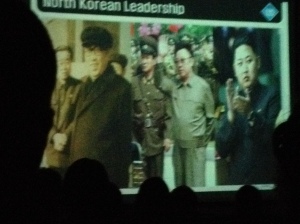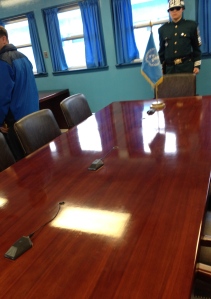As I’ve mentioned before, I’m pretty interested in the current political state of North Korea. So as my friend and I were planning our trip to the southernmost nation on the peninsula one of our top priorities was getting an opportunity to visit the DMZ, or Demilitarized Zone. For those who don’t know much about it, the DMZ is basically the dividing border between the north and the south. And, despite its name, it’s one of the most militarized areas in the world.
I won’t go into a lot of detail about the Korean War because if you’re reading this you have access to Wikipedia and (even better) actual history books, but one important point about it is that it never technically ended. In 1953 a ceasefire was agreed upon by Russia, China, and the United Nations, with Kim Il-Sung becoming the leader of the North, and Syngman Rhee becoming the leader of the South. The nation was divided at the now-famous 38th parallel, splitting the country effectively in half, and since then there’s been no large scale violent aggression. However, as I learned during my visit, small scale aggression continued for decades.
Right now tours are available through the USO in Seoul. My friend and I managed to book the 7:30 tour, which consisted of a packed bus of visitors, and which took about an hour to reach the JSA, or Joint Security Area. The bus ride itself was pretty interesting, as we got to meet people from all over the world who were just as interested as we were in seeing the DMZ. Equally interesting is the fact that not everyone has the opportunity to see the DMZ at all—in order to take the tour, you have to have a passport from a pre-approved list of countries. According to my friend, South Koreans aren’t even allowed to take the tour, because the American and South Korean militaries are worried about people who might use the opportunity to make some kind of overt political statement, which could potentially result in violence.
In any case, once we arrived at the JSA we had to wait for our guide, an American Sergeant, to retrieve us before we were allowed off the bus. Our entire tour actually had two guides, a Korean man who took us to the JSA and the surrounding areas, and the American man who actually took us to the DMZ. When the Sergeant arrived he gave us a short briefing, telling us about our itinerary and letting us know that if we took any pictures we weren’t supposed to we’d be booted off the tour. I was pretty impressed by him, because he managed to convey a good balance of no-BS authority with a good sense of humor. Once everyone was crystal clear on the rules we were taken to an auditorium where our Sergeant outlined some of the history of the Korean War and the DMZ, and then showed us a video that elaborated on the facts he’d given us. I think the whole thing took about twenty to thirty minutes. Oh yeah, and did I mention we had to sign a waiver relieving the military of any responsibility in the case of injury or death? Fun stuff.
After the video we piled into the bus and started heading into the DMZ. As we rode, our Sergeant pointed out various areas of interest, such as the anti-tank defense system, the minefields, and the electrified security fences. The area surrounding the border is fairly large, and more or less empty; ass far as you can see, there are empty fields and trees apparently inhabited only by the occasional group of birds and surrounded by barbed-wire fences. I’d call it eerie, but compared to some of the other stuff that we saw it was downright normal. During the drive our sergeant commented that because there’s no hunting at the DMZ wildlife has flocked there and you can often see all sorts of birds, deer, and even bears.
One area of particular interest is the Daeseong-dong, or the Freedom Village. It’s a South Korean village inside the DMZ that consists of about 250 people and is primarily an agricultural center. Our Sergeant told us that the people in this village earn roughly 80,000 US dollars a year, tax-free, because whatever crops they don’t sell in private markets the South Korean government will buy from them. So, it’s a small town of people who are completely loaded. Apparently in order to be considered a resident of the village you have to stay in the village for a certain number of days every year, although you’re allowed to go anywhere you like aside from that. And, significantly, inhabitants of the village are exempt from the mandatory two-year military service required of all other males in South Korea. Because of this, men aren’t allowed to marry into the village.
Another point of interest is the rescue phones that exist along the south side of the DMZ. The South Korean and American militaries installed various phones throughout the area so that if any North Korean citizens decide to defect they can call for help.
When we finally reached the border, our Sergeant had us form two single-file lines outside of the Freedom House, the building that stands directly in front of the border. Apparently it was built with the intended purpose of hosting meetings between political leaders of both nations, but it’s never actually been used for that. Anyway, our Sergeant gave us another briefing, and this is when things started to get a little bizarre. He said that we were not allowed to wave, point, or gesture toward anyone on the other side of the border, nor were we allowed to take pictures of anything on the South Korean side, including the Freedom House. We were then led out to the border, where we were told to stand in two lines once again while we were given information about the area.
There are a number of light blue buildings that line the border, which serve various purposes. Each of these buildings straddles the borderline, with one half standing in North Korea and one half standing in South Korea. One of them is used for conferenced between the nations, taking on the role originally meant for the Freedom House. Once we were standing in front of the border, our Sergeant urged us to take as many pictures as we wanted of the North side. As you can see from the pictures, there were three Republic of Korea (or ROK) soldiers and one American soldier standing guard on the South side, but no North Koreans. I suspect they remove the guards when tours are happening on the South side. In fact, the motto of the American soldiers at the JSA is “In Front of Them All”, a sentiment that I believe reflects the strong will required to constantly stare your enemies in the face.
I did actually see a North Korean man during the tour, but he was standing well away from the border, on the stairs of the Panmungak (the main building on the North side). You might be able to make him out in the following picture:
His behavior was pretty strange, too. At first he just stood looking at us through binoculars, but after a few minutes he moved behind one of the pillars standing in front of the doors to the Panmungak. Was he hiding? I don’t know. A few minutes after that he emerged again and commenced watching us. My friend, who had been on the DMZ tour before, told me that the last time he visited he saw not only a guard but also a man inside the Panmungak who was taking pictures of the visitors on the South side. So, likely there are photos of all the visitors coming to see the border.
At that point we were allowed to enter one of the blue buildings standing on the border. Inside was a fairly unremarkable conference room with simple but functional chairs and tables, as well as microphones. I’m pretty sure I remember our Sergeant saying that what happens in those rooms is constantly recorded, so likely there’s audio documentation of visits as well.
There were two ROK soldiers standing at attention in the room when we entered, guarding the building. One of them was standing in the center of the room, and another was standing guard at the door leading to the North side. According to our Sergeant, there was once an incident during which a North Korean soldier burst into the building and attacked the ROK soldier standing near the door. He tried to drag the ROK soldier into North Korea, but the ROK soldier managed to fight his way free. Since then, whenever there are a renovations or painting done in the building the workers wear harnesses attached to ropes so that the soldiers on the South side can pull them back if the North tries to abduct them.
There’s a long table in the center of the room divided by a row of microphones.
As we were looking around the room, our Sergeant pointed them out and said that it lines up with the borderline outside. “Everyone on that side of the room,” he said (which included me), “is in North Korea right now.”
So now, I guess I can technically say I’ve been to North Korea.



